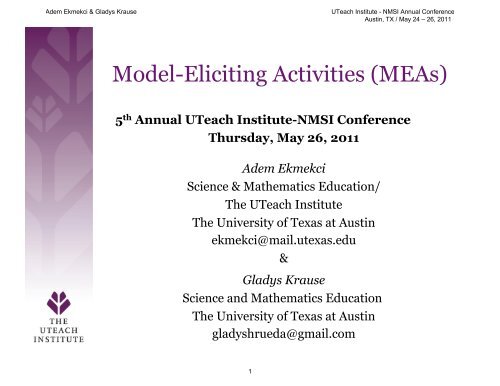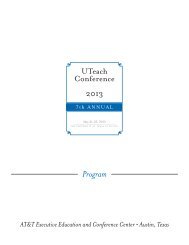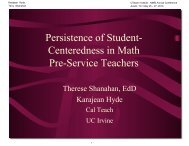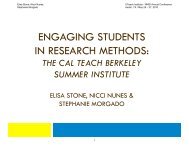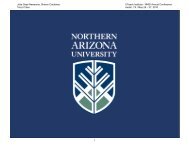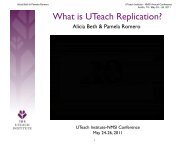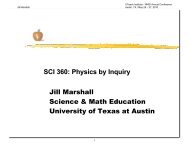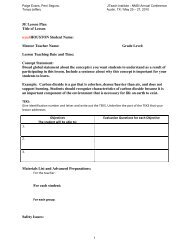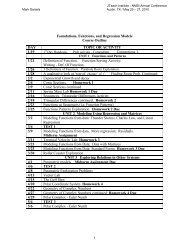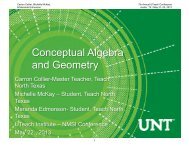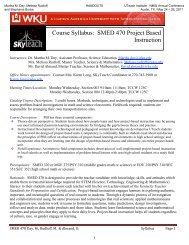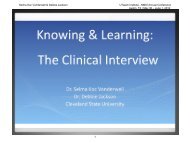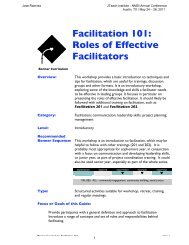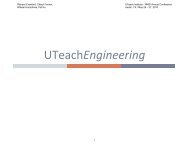Model-Eliciting Activities (MEAs) - The UTeach Institute
Model-Eliciting Activities (MEAs) - The UTeach Institute
Model-Eliciting Activities (MEAs) - The UTeach Institute
Create successful ePaper yourself
Turn your PDF publications into a flip-book with our unique Google optimized e-Paper software.
Adem Ekmekci & Gladys Krause<br />
<strong>UTeach</strong> <strong>Institute</strong> - NMSI Annual Conference<br />
Austin, TX / May 24 – 26, 2011<br />
<strong>Model</strong>-<strong>Eliciting</strong> <strong>Activities</strong> (<strong>MEAs</strong>)<br />
5 th Annual <strong>UTeach</strong> <strong>Institute</strong>-NMSI Conference<br />
Thursday, May 26, 2011<br />
Adem Ekmekci<br />
Science & Mathematics Education/<br />
<strong>The</strong> <strong>UTeach</strong> <strong>Institute</strong><br />
<strong>The</strong> University of Texas at Austin<br />
ekmekci@mail.utexas.edu<br />
&<br />
Gladys Krause<br />
Science and Mathematics Education<br />
<strong>The</strong> University of Texas at Austin<br />
gladyshrueda@gmail.com<br />
1
Adem Ekmekci & Gladys Krause<br />
<strong>UTeach</strong> <strong>Institute</strong> - NMSI Annual Conference<br />
Austin, TX / May 24 – 26, 2011<br />
<strong>Model</strong>-<strong>Eliciting</strong> <strong>Activities</strong> (<strong>MEAs</strong>)<br />
Agenda<br />
• Group Work: Solve an MEA in Groups<br />
• What are <strong>MEAs</strong>?<br />
• Designing <strong>MEAs</strong><br />
• Questions and Comments<br />
2
Adem Ekmekci & Gladys Krause<br />
<strong>UTeach</strong> <strong>Institute</strong> - NMSI Annual Conference<br />
Austin, TX / May 24 – 26, 2011<br />
<strong>Model</strong>-<strong>Eliciting</strong> <strong>Activities</strong> (<strong>MEAs</strong>)<br />
Group Work<br />
• Toolbox!<br />
• In groups of 3-4<br />
• Solve the problem ~30 min.<br />
• Present solutions and discuss ~10-15 min.<br />
3
Adem Ekmekci & Gladys Krause<br />
<strong>UTeach</strong> <strong>Institute</strong> - NMSI Annual Conference<br />
Austin, TX / May 24 – 26, 2011<br />
<strong>The</strong> Team Ranking<br />
Problem<br />
Summer Jobs Problem<br />
Carmona & Greenstein (2010).<br />
Investigating the Relationship<br />
Between the Problem and the<br />
Solver: Who Decides What Math<br />
Gets Used? In R. Lesh et al. (eds.),<br />
<strong>Model</strong>ing Students’ Mathematical<br />
<strong>Model</strong>ing Competencies.<br />
Case Studies for Kids<br />
Purdue University<br />
4
Adem Ekmekci & Gladys Krause<br />
<strong>UTeach</strong> <strong>Institute</strong> - NMSI Annual Conference<br />
Austin, TX / May 24 – 26, 2011<br />
<strong>Model</strong>-<strong>Eliciting</strong> <strong>Activities</strong> (<strong>MEAs</strong>)<br />
What are <strong>MEAs</strong>?<br />
• Thought-revealing activities that elicit students’<br />
mathematical and scientific knowledge (Lesh, 1999;<br />
Lesh & Doerr, 2003; and others),<br />
• Complex problem solving situation for students that<br />
incorporate the development of a mathematical or<br />
scientific model to describe a real-life situation,<br />
• Encourages students to describe, revise, and refine<br />
their mathematical and/or scientific ideas,<br />
• Encourages the use of representational media to<br />
explain and document students’ conceptual systems,<br />
5
Adem Ekmekci & Gladys Krause<br />
<strong>UTeach</strong> <strong>Institute</strong> - NMSI Annual Conference<br />
Austin, TX / May 24 – 26, 2011<br />
<strong>Model</strong>-<strong>Eliciting</strong> <strong>Activities</strong> (<strong>MEAs</strong>)<br />
What are <strong>MEAs</strong>?<br />
• Designed for small groups (3-4 people),<br />
• Similar to a Case Study version for Kids,<br />
• Introduce a problem related to a real life situation,<br />
- <strong>The</strong> context can be given in an introductory<br />
newspaper article -<br />
• <strong>The</strong>ir solution is a model describing a mathematical<br />
or scientific situation,<br />
• <strong>The</strong>y allow for multiple solutions.<br />
6
Adem Ekmekci & Gladys Krause<br />
<strong>UTeach</strong> <strong>Institute</strong> - NMSI Annual Conference<br />
Austin, TX / May 24 – 26, 2011<br />
<strong>Model</strong>-<strong>Eliciting</strong> <strong>Activities</strong> (<strong>MEAs</strong>)<br />
<strong>MEAs</strong> are designed to be:<br />
• Purposeful<br />
• Meaningful<br />
What are <strong>MEAs</strong>?<br />
And…<br />
• Elicit knowledge (models)<br />
7
Adem Ekmekci & Gladys Krause<br />
<strong>UTeach</strong> <strong>Institute</strong> - NMSI Annual Conference<br />
Austin, TX / May 24 – 26, 2011<br />
<strong>Model</strong>-<strong>Eliciting</strong> <strong>Activities</strong> (<strong>MEAs</strong>)<br />
What are <strong>MEAs</strong>?<br />
• Students’ different approaches to solving the problem<br />
are valued and recognized<br />
• Extending the notion of what it means to do<br />
mathematics and science extends the number of<br />
students who are capable of doing math and science<br />
• <strong>The</strong> group becomes greater than the sum of its parts<br />
• Diversity is seen as an asset that engages and<br />
promotes learning<br />
8
Adem Ekmekci & Gladys Krause<br />
<strong>UTeach</strong> <strong>Institute</strong> - NMSI Annual Conference<br />
Austin, TX / May 24 – 26, 2011<br />
Designing <strong>MEAs</strong><br />
6 Principles<br />
<strong>The</strong> Reality Principle<br />
<strong>The</strong> Simple Prototype Principle<br />
<strong>The</strong> <strong>Model</strong> Construction Principle<br />
<strong>The</strong> <strong>Model</strong>-Documentation Principle<br />
<strong>The</strong> <strong>Model</strong> Generalizibility Principle<br />
<strong>The</strong> Self-Evaluation Principle<br />
9
Adem Ekmekci & Gladys Krause<br />
<strong>UTeach</strong> <strong>Institute</strong> - NMSI Annual Conference<br />
Austin, TX / May 24 – 26, 2011<br />
Designing <strong>MEAs</strong><br />
<strong>The</strong> Reality Principle<br />
(Personal Meaningful Principle )<br />
• Could this really happen in a “real life” situation?<br />
• Will students be encouraged to make sense of the situation<br />
based on extensions of their own personal knowledge and<br />
experiences?<br />
10
Adem Ekmekci & Gladys Krause<br />
<strong>UTeach</strong> <strong>Institute</strong> - NMSI Annual Conference<br />
Austin, TX / May 24 – 26, 2011<br />
Designing <strong>MEAs</strong><br />
<strong>The</strong> Simple Prototype<br />
Principle<br />
• Is the situation as simple as possible, while still<br />
creating the need for a significant model?<br />
• Will the solution provide a useful prototype (or<br />
metaphor) for interpreting a variety of other<br />
structurally similar situations?<br />
11
Adem Ekmekci & Gladys Krause<br />
<strong>UTeach</strong> <strong>Institute</strong> - NMSI Annual Conference<br />
Austin, TX / May 24 – 26, 2011<br />
Designing <strong>MEAs</strong><br />
<strong>The</strong> <strong>Model</strong> Construction<br />
Principle<br />
• Does the task create the need for a model to be<br />
constructed, modified, extended, or redefined?<br />
• Does the task involve constructing, explaining,<br />
manipulating, predicting or controlling a structurally<br />
interesting system?<br />
• Is attention focused on underlying patterns &<br />
regularities rather than on surface-level<br />
characteristics?<br />
12
Adem Ekmekci & Gladys Krause<br />
<strong>UTeach</strong> <strong>Institute</strong> - NMSI Annual Conference<br />
Austin, TX / May 24 – 26, 2011<br />
Designing <strong>MEAs</strong><br />
<strong>The</strong> <strong>Model</strong> Documentation<br />
Principle<br />
• Will the response require students to explicitly reveal<br />
how they are thinking about the situation (givens,<br />
goals, possible solution paths)?<br />
• What kind of system (mathematical objects, relations,<br />
operations, patterns, regularities) are they thinking<br />
about?<br />
13
Adem Ekmekci & Gladys Krause<br />
<strong>UTeach</strong> <strong>Institute</strong> - NMSI Annual Conference<br />
Austin, TX / May 24 – 26, 2011<br />
Designing <strong>MEAs</strong><br />
<strong>The</strong> <strong>Model</strong> Generalization<br />
Principle<br />
• How shareable and reusable is the model developed<br />
by the students? Does it only apply to the particular<br />
problem, or can it be reused in other situations?<br />
14
Adem Ekmekci & Gladys Krause<br />
<strong>UTeach</strong> <strong>Institute</strong> - NMSI Annual Conference<br />
Austin, TX / May 24 – 26, 2011<br />
Designing <strong>MEAs</strong><br />
<strong>The</strong> Self-Evaluation<br />
Principle<br />
• Will the students be able to determine the usefulness<br />
of alternative responses?<br />
• Will students be able to determine when their<br />
responses are good enough?<br />
• Why does the client need the students’ result? For<br />
what purposes? Under which circumstances?<br />
15
Adem Ekmekci & Gladys Krause<br />
<strong>UTeach</strong> <strong>Institute</strong> - NMSI Annual Conference<br />
Austin, TX / May 24 – 26, 2011<br />
Multi-tier Design of thought revealing<br />
activities that promote research,<br />
teaching, and learning<br />
(Based on Lesh & Kelly, 1999)<br />
16
Adem Ekmekci & Gladys Krause<br />
<strong>UTeach</strong> <strong>Institute</strong> - NMSI Annual Conference<br />
Austin, TX / May 24 – 26, 2011<br />
<strong>Model</strong>ing Cycles in <strong>MEAs</strong><br />
Example: Historic Hotels MEA<br />
Problem:<br />
<strong>The</strong>re is a client who inherited a historic hotel and does<br />
not have management skills. He wants to determine the<br />
rate per room where he was told by the previous owner<br />
that all of 80 rooms are occupied when the daily rate is<br />
$60 per room; the rate per room increases by $1 for every<br />
vacant room; and each occupied room has a $4 cost for<br />
service and maintenance.<br />
(Based on Aliprantis & Carmona, 2003)<br />
17
Adem Ekmekci & Gladys Krause<br />
<strong>UTeach</strong> <strong>Institute</strong> - NMSI Annual Conference<br />
Austin, TX / May 24 – 26, 2011<br />
<strong>Model</strong>ing Cycles in <strong>MEAs</strong><br />
Example: Historic Hotels MEA<br />
<strong>The</strong>se are the most common testing<br />
-revising cycles emerged from<br />
students’ solution process of the<br />
Historic Hotels problem.<br />
(Based on Ekmekci & Dominguez, 2007)<br />
18
Adem Ekmekci & Gladys Krause<br />
<strong>UTeach</strong> <strong>Institute</strong> - NMSI Annual Conference<br />
Austin, TX / May 24 – 26, 2011<br />
<strong>Model</strong>-<strong>Eliciting</strong> <strong>Activities</strong> (<strong>MEAs</strong>)<br />
• QUESTIONS...<br />
• COMMENTS...<br />
Adem Ekmekci & Gladys Krause<br />
ekmekci@mail.utexas.edu<br />
gladyshrueda@gmail.com<br />
<strong>The</strong> University of Texas at Austin<br />
19
Adem Ekmekci & Gladys Krause<br />
<strong>UTeach</strong> <strong>Institute</strong> - NMSI Annual Conference<br />
Austin, TX / May 24 – 26, 2011<br />
References<br />
Aliprantis, C.D. & Carmona, G. (2003). Introduction to an economic<br />
problem: A <strong>Model</strong>s and <strong>Model</strong>ing Perspective. In R. Lesh & H. Doerr<br />
(Eds.), Beyond constructivism: <strong>Model</strong>s and modeling perspectives on<br />
mathematics problem solving, learning, and teaching (pp. 255-264).<br />
Mahwah, NJ: Erlbaum.<br />
Carmona, G. & Greenstein, S. (2010). Investigating the Relationship<br />
Between the Problem and the Solver: Who Decides What Math Gets<br />
Used? In R. Lesh et al. (eds.), <strong>Model</strong>ing Students’ Mathematical<br />
<strong>Model</strong>ing Competencies, DOI 10.1007/978-1-4419-0561-1_21, C<br />
Springer Science+Business Media, LLC 2010.<br />
Ekmekci, A. and Dominguez, A. (2007, Oct) "College Level Students’<br />
Reasoning of an Optimization Problem: Historic Hotel MEA (<strong>Model</strong><br />
-<strong>Eliciting</strong> Activity)" Paper presented at the annual meeting of the North<br />
American Chapter of the International Group for the Psychology of<br />
Mathematics Education, University of Nevada, Reno, Reno, Nevada<br />
Retrieved from http://www.allacademic.com/met/p201387_index.html<br />
Publication Type: Poster<br />
20
Adem Ekmekci & Gladys Krause<br />
<strong>UTeach</strong> <strong>Institute</strong> - NMSI Annual Conference<br />
Austin, TX / May 24 – 26, 2011<br />
References<br />
Lesh, R. & Doerr H. M. (Eds.), 2003. Beyond Constructivism. Manwah,<br />
NJ: Lawrence Erlbaum Associates.<br />
Lesh, R., Hoover, M., Hole, B., Kelly, A. E., & Post, T. (2000). Principles<br />
for developing thought-revealing activities for students and teachers. In<br />
A. E. Kelly & R. A. Lesh (Eds.), Handbook of research design in<br />
mathematics and science education (pp. 591-646). Mahwah, NJ:<br />
Lawrence Erlbaum Associates, Inc.<br />
21
Adem Ekmekci & Gladys Krause HANDOUTS <strong>UTeach</strong> <strong>Institute</strong> - NMSI Annual Conference<br />
Austin, TX / May 24 – 26, 2011<br />
College Level Students’ Reasoning of an Optimization Problem:<br />
Historic Hotel MEA (<strong>Model</strong>-<strong>Eliciting</strong> Activity)<br />
Adem Ekmekci<br />
University of Texas at Austin<br />
ekmekci@mail.utexas.edu<br />
Angeles Domínguez<br />
Instituto Tecnologico de Estudios<br />
Superiores de Monterrey<br />
angeles.dominguez@itesm.mx<br />
<strong>Model</strong>-eliciting activities (<strong>MEAs</strong>) are based on real-life situations where students,<br />
working in small groups, present a mathematical model as a solution to a client’s need<br />
(Zawojewski and Carmona, 2001). <strong>The</strong> problem of Historic Hotels is an MEA in which<br />
students are asked to develop a mathematical model to maximize profit that can be<br />
calculated with a quadratic equation. In the problem, there is a client who inherited a<br />
historic hotel and does not have management skills. He wants to determine the rate per<br />
room where he was told by the previous owner that all of 80 rooms are occupied when<br />
the daily rate is $60 per room; the rate per room increases by $1 for every vacant room;<br />
and each occupied room has a $4 cost for service and maintenance. <strong>The</strong> problem can be<br />
solved by using quadratic formulas, 1 st and 2 nd derivative method, or simply looking at<br />
the profit for each value. In this study, college level students are asked to solve this<br />
optimization problem to see possible their ways of solution to the problem. Two groups<br />
of students were given this non-traditional problem. <strong>The</strong> first group was a calculus class<br />
where the majority of students were engineering major and the second one was an<br />
education course required for teaching certification where students were either science or<br />
math major. <strong>The</strong>re were 23 groups of 3 in calculus class and 11 groups of 3 in the other.<br />
After the problem was solved in groups, students were asked to present their<br />
models to their class-mates. Discussions about different solutions were done after each<br />
presentation. Authors and their colleagues observed students and took field notes while<br />
students were working on the problem and discussing their results afterwards. This<br />
particular type of MEA made students’ thinking about optimization as a mathematical<br />
concept visible to both their peers and teachers. Formative assessment (Black & William,<br />
1998) cycles that students went through appeared in the problem solving process.<br />
Students’ final works are analyzed in terms of the function they used, variables and their<br />
definitions, graphical representations, and generalizations.<br />
Analysis of solutions of both groups to the problem and observations by authors<br />
and their colleagues will be reported in the poster. In addition, math major students’ and<br />
pre-service teachers’ ways of thinking will be discussed. Following questions will also be<br />
touched upon in the poster:<br />
- How much calculus knowledge do college level students associate with solving an<br />
optimization problem?<br />
- In what ways, did college level students model the maximization of profit in the<br />
given context?<br />
- What symbols and tool did students use in solving the problem?<br />
- Were there any differences in the method used between calculus students and<br />
students in teacher certification program?<br />
1
Adem Ekmekci & Gladys Krause HANDOUTS <strong>UTeach</strong> <strong>Institute</strong> - NMSI Annual Conference<br />
Austin, TX / May 24 – 26, 2011<br />
References<br />
Aliprantis, C.D. & Carmona, G. (2003). Introduction to an economic problem: A <strong>Model</strong>s<br />
and <strong>Model</strong>ing Perspective. In R. Lesh & H. Doerr (Eds.), Beyond constructivism: <strong>Model</strong>s<br />
and modeling perspectives on mathematics problem solving, learning, and teaching (pp.<br />
255-264). Mahwah, NJ: Erlbaum.<br />
Black, P. & Wiliam, D. (1998). Inside the black box: raising standards through classroom<br />
assessment. Phi Delta Kappan, October 1998, 139-148.<br />
Dominguez, A. (2007). Single solution, multiple perspectives. Proceedings of thirteenth<br />
annual meeting of <strong>The</strong> International Community of Teachers of Mathematical <strong>Model</strong>ing<br />
and Applications (ICTMA). Bloomington, IN.<br />
Lesh, R., Hoover, M., Hole, B., Kelly, E., & Post, T. (2000). Principles for developing<br />
thought revealing activities for students and teachers. In A. E. Kelly & R. A. Lesh (Eds.),<br />
Handbook of research design in mathematics and science education (pp. 591-645).<br />
Mahaway, NJ: Lawrence Erlbaum.<br />
Zawojewski, J., & Carmona, G. (2001). A developmental and social perspective on<br />
problem solving strategies. In R. Speiser & C. Walter (Eds.), Proceedings of the twentythird<br />
annual meeting of the north American chapter of the international group for the<br />
psychology of mathematicseducation.<br />
Columbus, OH: ERIC Clearinghouse for Science, Mathematics, and Environmental<br />
Education.<br />
Citation for this proceeding:<br />
Ekmekci, A. and Dominguez, A. (2007, Oct) "College Level Students’ Reasoning of an<br />
Optimization Problem: Historic Hotel MEA (<strong>Model</strong>-<strong>Eliciting</strong> Activity)" Paper presented at the<br />
annual meeting of the North American Chapter of the International Group for the Psychology of<br />
Mathematics Education, University of Nevada, Reno, Reno, Nevada Online Retrieved<br />
2008-09-04 from http://www.allacademic.com/meta/p201387_index.html<br />
Publication Type: Poster<br />
2
<br />
Adem Ekmekci & Gladys Krause HANDOUTS <strong>UTeach</strong> <strong>Institute</strong> - NMSI Annual Conference<br />
<br />
<br />
College Students’ Reasoning in an <br />
Optimization Problem <br />
INTRODUCTION<br />
<strong>Model</strong>-eliciting activities (<strong>MEAs</strong>) present a problem based on<br />
real-life situations to be solved by students in small groups (Lesh et.<br />
al., 2000; Zawojewski & Carmona, 2001). <strong>The</strong> activity used in this<br />
study, the Historic Hotel Problem designed by Aliprantis and<br />
Carmona (2003), is a model-eliciting activity with single numerical<br />
answer with multiple solutions (Dominguez, 2007). Through <strong>MEAs</strong><br />
students’ ways of thinking, as they work on the problem, become<br />
visible to the teacher as well as to their peers (Lesh et. al., 2000). In<br />
that sense, <strong>MEAs</strong> are thought-revealing activities in which students<br />
express their initial ideas and revise them according to feedback they<br />
get from their peers.<br />
SIGNIFICANCE<br />
Classroom practices play a crucial role in efforts to improve<br />
student learning. One of the most important steps for teachers to<br />
accomplish this goal is to know what their students know. Black &<br />
William (1998) defined classroom assessment as the activities<br />
undertaken by teachers and students to provide information about<br />
how students think and what they know. <strong>MEAs</strong> can be used and be<br />
very beneficial as a non-traditional way of classroom assessment.<br />
<strong>MEAs</strong> usually start with a newspaper article that warms student to<br />
problem statement. Readiness questions related to the article make<br />
us sure that all students are ready to the problem. Finally, problem<br />
statement emphasizes the need of a model rather than just a numeric<br />
answer. As the output of <strong>MEAs</strong>, attention should be paid to the<br />
model students develop rather than the numerical answer. That is,<br />
descriptions, explanations, constructions, and the math student use<br />
(Lesh et. al., 2000) in their models are more important than their<br />
single-numerical answer to the problem.<br />
PARTICIPANTS & THE ACTIVITY<br />
This study is an extended version of an earlier study conducted by<br />
Dominguez (2007) with an addition of 30 pre-service science and<br />
math teachers (10 groups of 3) to 94 calculus students (23 groups of<br />
4 or 5) at a university in central Texas. <strong>The</strong> activity was done in two<br />
episodes, 50-60 minutes each. In the first episode, students read the<br />
newspaper article and answered the readiness questions as a class.<br />
<strong>The</strong>n, they worked on the problem in groups.<br />
In the second episode, students completed their letters and each<br />
group presented their models to other groups and discussed their<br />
ways of solving.<br />
PROBLEM STATEMENT<br />
Mr. Frank Graham has just inherited a historic hotel with 80<br />
rooms. He is told that all of the rooms were occupied when the<br />
daily rate was $60 per room and, for every dollar increase in the<br />
daily rate, one less room is rented (if the daily rate was $61, 79<br />
rooms would be occupied). Each occupied room has a $4 cost for<br />
service and maintenance per day. Mr. Graham would like to know<br />
how much he should charge per room in order to maximize his<br />
profit, what his profit would be at that rate, and a procedure for<br />
finding the daily rate that would maximize his profit in the future<br />
even if the hotel prices and the maintenance costs change.<br />
THE PURPOSE OF THE STUDY<br />
We focused on the following questions:<br />
• What different models and optimization strategies were there?<br />
• How many college level students incorporated calculus<br />
knowledge and at what level?<br />
• Were there any difference in solution ways of calculus<br />
students and pre-service math and science teachers?<br />
• Were there any particular testing and revising cycles students<br />
went through?<br />
DATA COLLECTION<br />
All of students’ written work was analyzed and field notes were<br />
taken by researchers during the solution process.<br />
Strategy <br />
SINGLE ANSWER – MULTIPLE<br />
PERSPECTIVES<br />
Calculus groups <br />
(n=23) <br />
Adem Ekmekci <br />
Department of Science & Mathematics Education <br />
University of Texas at Austin <br />
Pre‐service Teacher <br />
Groups (n=10) <br />
Derivative 24 5 <br />
Table 1 1 <br />
Graph 1 1 <br />
Vertex formula 1 1 <br />
Historic Hotel MEA (<strong>Model</strong>‐<strong>Eliciting</strong> Activity) <br />
Total 27* 8** <br />
*3 groups gave 2 solutions and 1 group used a different strategy to verify.<br />
**<strong>The</strong> optimization strategy of 2 groups could not be identified.<br />
All calculus groups used derivative strategy, whereas 5 out of 8<br />
of pre-service teacher groups favored that method.<br />
n <br />
x <br />
y <br />
r <br />
& <br />
Austin, TX / May 24 – 26, 2011<br />
Angeles Domínguez <br />
Instituto Tecnologico de Estudios <br />
Superiores de Monterrey <br />
Functions and Variables in Students’ Solutions<br />
Definition of <br />
variables <br />
<strong>Model</strong>ing Function <br />
# of vacant P(n) = (80 ‐ n)(56 + n) <br />
rooms P(r) = (80 ‐ r)(56 + r) <br />
# of occupied P = x y ‐ 4 x & y = 140 ‐ x <br />
rooms P(x) = x (140 ‐ x) ‐ 4 x <br />
Daily rate P = x y ‐ 4 x & x = 140 ‐ y <br />
per room P(y) = y (140 ‐ y) ‐ 4 (140 ‐ y) <br />
Amount raise P(y) = (80 ‐ (y ‐ 60)) (y – 4) <br />
in daily rate P(y) = (y – 4) (140 ‐ y) <br />
Calculus <br />
Students <br />
<br />
Pre‐service <br />
Teachers <br />
20 5 <br />
2 4 <br />
2 2 <br />
2 0 <br />
Total 26* 11** <br />
*Three teams gave two solutions <br />
** One team gave two solutions <br />
<br />
Test-Revise Cycles<br />
<strong>The</strong>se are the most common testingrevising<br />
cycles emerged from students’<br />
solution process of the problem. <strong>The</strong> most<br />
common pattern was I – II – III. A few<br />
groups went through all cycles and very<br />
few groups did not use III at all: they went<br />
through I – II – IV. <strong>The</strong>se were all preservice<br />
teachers<br />
CONCLUSIONS<br />
Although it seems like there is one single-numerical answer to the<br />
Historic Hotel Problem, students used 4 different strategies for<br />
optimization. Moreover, the modeling functions students developed can<br />
be classified into four groups. From students’ written work, it was<br />
possible to see that there are multiple pathways to find a singlenumerical<br />
answer. Observing students during the modeling process<br />
made it possible to see how they went through various modeling cycles<br />
(Lesh et. al., 2000) to develop their models. Calculus students were<br />
more likely to use derivative strategy than pre-service teachers, as<br />
expected.<br />
REFERENCES:<br />
Aliprantis, C.D. & Carmona, G. (2003). Introduction to an economic problem: A <strong>Model</strong>s and <strong>Model</strong>ing Perspective. In R. Lesh & H. Doerr (Eds.), Beyond constructivism: <strong>Model</strong>s and modeling perspectives on mathematics problem solving, learning, and teaching (pp. 255-264). Mahwah, NJ: Erlbaum.<br />
Black, P. & Wiliam, D. (1998). Inside the black box: raising standards through classroom assessment. Phi Delta Kappan, October 1998, 139-148.<br />
Dominguez, A. (2007). Single solution, multiple perspectives. Proceedings of thirteenth annual meeting of <strong>The</strong> International Community of Teachers of Mathematical <strong>Model</strong>ing and Applications (ICTMA). Bloomington, IN.<br />
Lesh, R., Hoover, M., Hole, B., Kelly, E., & Post, T. (2000). Principles for developing thought revealing activities for students and teachers. In A. E. Kelly & R. A. Lesh (Eds.), Handbook of research design in mathematics and science education (pp. 591-645). Mahaway, NJ: Lawrence Erlbaum.<br />
Zawojewski, J., & Carmona, G. (2001). A developmental and social perspective on problem solving strategies. In R. Speiser & C. Walter (Eds.), Proceedings of the twenty-third annual meeting of the north American chapter of the international group for the psychology of mathematicseducation.<br />
Columbus, OH: ERIC Clearinghouse for Science, Mathematics, and Environmental Education.<br />
3
Adem Ekmekci & Gladys Krause HANDOUTS <strong>UTeach</strong> <strong>Institute</strong> - NMSI Annual Conference<br />
Austin, TX / May 24 – 26, 2011<br />
Summer Jobs Case Study 1<br />
Newspaper Article: Heat Is on for Summertime Jobs.<br />
Saturday is the Meers Middle School’s annual job fair, organized by the Youth Action<br />
Club. <strong>The</strong> fair gives students an early start to plan how they will earn money during the<br />
summer.<br />
It also honors innovative work efforts. This year’s Earnest Earner award went to<br />
seventh-grader Tyrone Wakes. His Kids on the Run service provided mail pickup, errand<br />
running, and pet walking for residents in his apartment complex.<br />
“Summer jobs are big business,” claims Randy Tye, President of Youth Action. “Our<br />
fair gives ideas about the kinds of jobs kids can get and the money they can earn. We<br />
will hand out information on pay rates for different jobs and advice on ‘talking money’<br />
with employers.”<br />
<strong>The</strong> fair will show how to track down hard-to-get jobs. Student Greg Maby reports,<br />
“<strong>The</strong> basic idea is to go after the jobs. Don’t wait for them to come to you. It’s up to<br />
kids to show what they can do. We’ll give money-making tips, like how to win babysitting<br />
jobs by getting to know young children in the neighborhood.”<br />
Students Jack Elliot drums up yard work by mowing his own lawn early on Saturday<br />
mornings. “Wake up and smell the grass clippings! Is my motto. When people see the<br />
job I do on my parents’ lawn, they often ask me to do theirs.” Showing off your skills is<br />
a good way to attract business.<br />
Visitors to the fair can take a lesson on washing cars for fun and profit. Prices for<br />
commercial car washes are high enough hat young people can compete for the business.<br />
Tye says, “Most adults don’t care who washes their car. If you provide services as good<br />
as others but at a better price, you’ll get the job.”<br />
A profit-making venture often overlooked is services for the elderly. As life<br />
expectancy increases, people live longer, and they can use different kinds of help. Senior<br />
citizens often need help shopping, clearning hourse, or doing yard work. Households<br />
with infirm elderly may need someone to visit with then, so that family members can take<br />
a break.<br />
Jenny Crisp says, “Believe it or not, my baby-sitting job is with my next-door<br />
neighbor’s grandmother. She has Alzheimer’s disease. We read stories together.<br />
Sometimes I play my flute. We have a good time and I also get paid. I’m going into<br />
medical research when I grow up. I’d like to find a cure for Alzheimer’s.”<br />
Today’s students use brochures to get summer jobs. Teacher Helen Soleski says, “Our<br />
computer lab has software for designing flyers that advertise job skills and experience.<br />
Some students design resumes giving potential employers information about their<br />
training and previous work experience.”<br />
Eighth-grader Justin Shar says, “My resume tells about the baby-sitting I’ve done in<br />
the past, my class in first aid, and my advanced swimmer’s certificate. I listed references<br />
with names and phone numbers of people I worked for. <strong>The</strong>y gave me such good<br />
recommendations that I got five job offers.”<br />
Sixth-grader Marsha Turi advises, “Don’t give up. Last year I made flyers, went doorto-door,<br />
and advertised on bulletin boards. I must have asked a hundred people for work.<br />
I got ninety-nine no’s and one very good job that lasted all summer. By September, I had<br />
put $350 in the bank. I did such a good job that I expect to get the job again next<br />
summer.”<br />
4
Adem Ekmekci & Gladys Krause HANDOUTS <strong>UTeach</strong> <strong>Institute</strong> - NMSI Annual Conference<br />
Austin, TX / May 24 – 26, 2011<br />
Summer Jobs Case Study 2<br />
Typical Pay for Student Summer Jobs<br />
Washing Cars<br />
Own Parents<br />
Others<br />
$2/car MEDIAN $4/car<br />
$2 to $5 LOW/HIGH $3 to $6<br />
Lawn Mowing<br />
Own Parents<br />
Others<br />
$5/lawn MEDIAN $10/car<br />
$3 to $10 LOW/HIGH $5 to $15<br />
Paper Routes<br />
MEDIAN<br />
$12.50/week<br />
LOW/HIGH $7 to $25<br />
5
Adem Ekmekci & Gladys Krause HANDOUTS <strong>UTeach</strong> <strong>Institute</strong> - NMSI Annual Conference<br />
Austin, TX / May 24 – 26, 2011<br />
Summer Jobs Case Study 3<br />
READINESS QUESTIONS<br />
1. About how much money might a student earn mowing his or her parent's lawn<br />
once a week for a month? Be sure to show your calculations below.<br />
2. About how much might a student earn mowing 10 average-size lawns once a<br />
week for a month? Show your calculations below.<br />
3. About how much might a student earn in a month mowing 5 small-size lawns<br />
once a week and 5 average-size lawns once every two weeks? Show your<br />
calculations below.<br />
4. Next summer Jack Elliot wants to do more than just yard work. He plans to mow<br />
10 yards, get a newspaper route, and wash cars on Saturdays. Jack wants to know<br />
about how much money he can realistically expect to make during the summer,<br />
but this depends on many things, such as how often he mows a lawn or how big<br />
the lawn is.<br />
Estimate what his earnings might be and list the assumptions you make. Give at<br />
least 5 of your assumptions.<br />
6
Adem Ekmekci & Gladys Krause HANDOUTS <strong>UTeach</strong> <strong>Institute</strong> - NMSI Annual Conference<br />
Austin, TX / May 24 – 26, 2011<br />
Summer Jobs Case Study 4<br />
Last summer Maya started a concession business at Wild Days Amusement Park. Her<br />
vendors carry popcorn and drinks around the park, selling wherever they can find<br />
customers. Maya needs your help deciding which workers to rehire next summer.<br />
Last year Maya had nine vendors. This summer, she can have only six – three full-time<br />
and three half-time. She wants to rehire the vendors who will make the most money for<br />
her. She doesn’t know how to compare them because they worked different numbers of<br />
hours. Also, when they worked makes a big difference. After all, it is easier to sell more<br />
on a crowded Friday night than a rainy afternoon.<br />
Maya reviewed her records from last year. For each vendor, she totaled the number of<br />
hours worked and the money collected – when business in the park was busy (high<br />
attendance), steady (medium attendance), and slow (low attendance). (See the tables.)<br />
Please evaluate how well the different vendors did last year for the business and decide<br />
which three she should rehire full-time and which three she should rehire half-time.<br />
Write a letter to Maya giving your results. In your letter describe how you evaluated the<br />
vendors. Give details so Maya can check your work, and give a clear explanation so she<br />
can decide whether your method is a good one for her to use.<br />
7
Adem Ekmekci & Gladys Krause HANDOUTS <strong>UTeach</strong> <strong>Institute</strong> - NMSI Annual Conference<br />
Austin, TX / May 24 – 26, 2011<br />
Summer Jobs Case Study 5<br />
HOURS WORKED LAST SUMMER<br />
June July August<br />
Busy Steady Slow Busy Steady Slow Busy Steady Slow<br />
MARIA 12.5 15 9 10 14 17.5 12.5 33.5 35<br />
KIM 5.5 22 15.5 53.5 40 15.5 50 14 23.5<br />
TERRY 12 17 14.5 20 25 21.5 19.5 20.5 24.5<br />
JOSE 19.5 30.5 34 20 31 14 22 19.5 36<br />
CHAD 19.5 26 0 36 15.5 27 30 24 4.5<br />
CHERI 13 4.5 12 33.5 37.5 6.5 16 24 16.5<br />
ROBIN 26.5 43.5 27 67 26 3 41.5 58 5.5<br />
TONY 7.5 16 25 16 45.5 51 7.5 42 84<br />
WILLY 0 3 4.5 38 17.5 39 37 22 12<br />
MONEY COLLECTED LAST SUMMER<br />
June July August<br />
Busy Steady Slow Busy Steady Slow Busy Steady Slow<br />
MARIA 690 780 452 699 758 835 788 1732 1462<br />
KIM 474 874 406 4612 2032 477 4500 834 712<br />
TERRY 1047 667 284 1389 804 450 1062 806 491<br />
JOSE 1263 1188 765 1584 1668 449 1822 1276 1358<br />
CHAD 1264 1172 0 2477 681 548 1923 1130 89<br />
CHERI 1115 278 574 2972 2399 231 1322 1594 577<br />
ROBIN 2253 1702 610 4470 993 75 2754 2327 87<br />
TONY 550 903 928 1296 2360 2610 615 2184 2518<br />
WILLY 0 125 64 3073 767 768 3005 1253 253<br />
Figures are given for times when park attendance was high (busy), medium (steady), and low (slow).<br />
8
Adem Ekmekci & Gladys Krause HANDOUTS <strong>UTeach</strong> <strong>Institute</strong> - NMSI Annual Conference<br />
Austin, TX / May 24 – 26, 2011<br />
THE TEAM RANKING PROBLEM<br />
Each point in the figure below represents the win-loss record of<br />
each of the twelve elementary school soccer teams in Flat Mountain<br />
School District.<br />
READINESS QUESTIONS<br />
1. Which team(s) won the most games? How do you know?<br />
2. Which team(s) lost the most games? How do you know?<br />
3. Did all teams play the same number of games? How do you know?<br />
9
Adem Ekmekci & Gladys Krause HANDOUTS <strong>UTeach</strong> <strong>Institute</strong> - NMSI Annual Conference<br />
Austin, TX / May 24 – 26, 2011<br />
THE PROBLEM<br />
Your task is to develop a method for determining which of the<br />
twelve teams wins the first, second, third, fourth, and fifth place trophies.<br />
Make sure you explain very clearly why the teams should be ranked this<br />
way, so that the kids on all the teams will understand that your system is<br />
fair.<br />
<strong>The</strong>re are twelve teams in the Flat Mountain School District, but<br />
many, many more in the whole state! At the end of the season, the state<br />
soccer officials will need to find the top five teams for the state. Write<br />
a letter to the soccer officials where you explain how your system works<br />
and why it is fair. Make sure the officials will understand how to use your<br />
ranking system for any number of teams.<br />
10
Adem Ekmekci & Gladys Krause HANDOUTS <strong>UTeach</strong> <strong>Institute</strong> - NMSI Annual Conference<br />
Austin, TX / May 24 – 26, 2011<br />
11
Adem Ekmekci & Gladys Krause HANDOUTS <strong>UTeach</strong> <strong>Institute</strong> - NMSI Annual Conference<br />
Austin, TX / May 24 – 26, 2011<br />
12
Adem Ekmekci & Gladys Krause HANDOUTS <strong>UTeach</strong> <strong>Institute</strong> - NMSI Annual Conference<br />
Austin, TX / May 24 – 26, 2011<br />
13
Adem Ekmekci & Gladys Krause HANDOUTS <strong>UTeach</strong> <strong>Institute</strong> - NMSI Annual Conference<br />
Austin, TX / May 24 – 26, 2011<br />
14
Adem Ekmekci & Gladys Krause HANDOUTS <strong>UTeach</strong> <strong>Institute</strong> - NMSI Annual Conference<br />
Austin, TX / May 24 – 26, 2011<br />
15
Adem Ekmekci & Gladys Krause HANDOUTS <strong>UTeach</strong> <strong>Institute</strong> - NMSI Annual Conference<br />
Austin, TX / May 24 – 26, 2011<br />
16


